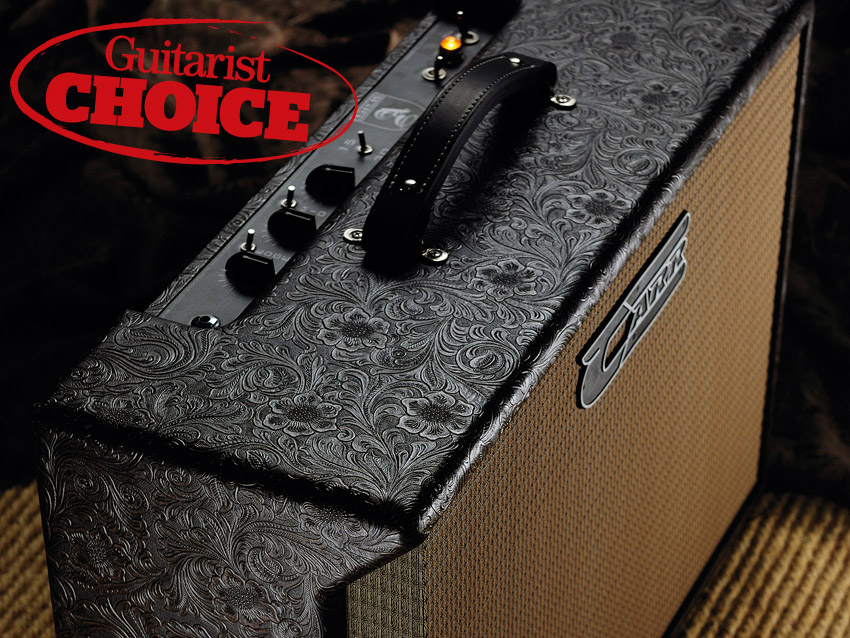MusicRadar Verdict
Like many boutique amps, the Artemus is zeroed-in on a particular vibe. If you get it, you'll be blown away by this amp.
Pros
- +
Superlative craftsmanship. Great tone when cranked.
Cons
- -
It's aimed at those who can run it at full blast, so it's less rewarding for home use.
MusicRadar's got your back

Carr Artemus 30

Carr Artemus 30

Carr Artemus 30

http://www.youtube.com/watch?v=tzS0dc3n6-Q&feature=player_embedded
Based in North Carolina, Steve Carr has steadily been going from strength to strength, and as his reputation grows, so does his user list. You don't get players such as Nils Lofgren, Richie Sambora or Joe Perry on board unless your guitar amps are something special, and Carr Amps is certainly doing that.
Steve's latest model is the Artemus, named after the Wild Wild West character Artemus Gordon. Unveiled earlier this year, it's the first Carr amp to use EL84 output valves, with some typical Carr twists.
"The Artemus is a true point-to-point amplifier - there are no circuit boards of any kind... everything is wired from one component to the next."
"To be honest I struggled with this amp at first," says Carr. "Our Japanese importer asked us to do something Vox-inspired, however I found when prototyping the classic Vox circuits that the sound was a bit obscure for my taste. The thickness was very nice, but I crave articulation.
"So after a lot of trial and error I went for fixed bias EL84s instead of the usual cathode bias with no negative feedback, and a very simple preamp, which has more in common with the AC15 EF86 front-end than anything else.
"I used EF86s at first, which sounded very good, but in a combo the microphonics proved insurmountable. So I developed a cascode circuit using the 12AX7, which I voiced and set the gain characteristics to be about the same as the EF86. I feel now it's superior!"
Outwardly, the Artemus lives up to the very high standard we've come to expect from the Carr cabinet shop. The asymmetric design is a Carr trademark that's used on some of its amps; it takes a little getting used to but has an undeniably cool retro-European look to it.
The asymmetric theme is also echoed on the rear panel, which has a sloping bottom edge below the valve inspection cut-out. This particular cabinet is covered in a tooled leather-effect antique brown fabric, which looks absolutely stunning.
The cabinet's perfectly radiused corners are covered in an almost seamless flow of vinyl that's so perfectly applied it looks as though it's been sprayed on. The Artemus's electrics are contained in a precision-folded aluminium chassis with neatly welded corners.
Like all Carr designs, the Artemus is a true point-to-point amplifier - there are no circuit boards inside of any kind, instead everything is wired from one component lead to the next, or joined to one of several tag strips.
While the assembly method may be rooted in the thirties, some of the components Carr uses inside its amps are cutting edge, such as Solen polypropylene fast capacitors for filtering instead of the usual electrolytic types, which tend to dry out and eventually need replacing.
The Artemus is a fairly straightforward single-channel design with some typical Carr twists: the rotary controls consist of volume, bass and treble, then there are three small but interesting toggle switches.
The first two are called edge and mid: edge emphasises high frequencies, while mid can either be scooped out for a more Fender-influenced tone, or left flat for the early Vox vibe, which is the Artemus's party piece. In the flat position, there's substantially more gain, making it easier to overdrive.
The third small toggle switches off two of the Valve Art EL84 output valves, changing the Artemus from 30 to 15 watts.
The mains switch has two 'on' positions, which reverse the incoming mains polarity if needed. This can reduce background mains hum in certain situations.
Overall, the Artemus is typical of the exceptional build standards we're used to seeing from Carr and should easily handle anything that a player might want to use it for, from occasional bedroom use to endless touring.
Sounds
At lower volume levels the Artemus has a very detailed clean sound, which can easily be tailored to suit any guitar using the edge and mid toggle switches. Both tone controls interact smoothly with no annoying peaks and make it very easy to dial the Artemus in.
The edge toggle adds highs but without making the amp sound shrill, while disengaging the mid toggle provides a nice take on Fender's classic 'Blackface' tone - not quite as jaw-droppingly sweet as some other Carrs we've tried but still very satisfying.
Switching the mid in adds a good deal of punch and increases gain, coming very close to that warm and slightly boxy grind that typifies the early AC sound. As you increase the volume, the tone thickens up considerably, with the power stage taking over at around halfway.
Beyond this point you need to start reducing bass to keep things under control, meanwhile the Artemus just sounds better and better the louder you go. At full power, with everything on except the bass, which is turned fully off, you get a superb classic rock tone with wonderful dynamic response. It's thick, punchy and with just enough bite for it to cut through without losing that classic Brit tone.
Even at this extreme level the amp is still totally coherent, with all the articulation that's so important to its designer. We used a '94 PRS McCarty and a Fender Custom Shop '51 Nocaster, both of which sound truly magnificent plugged into the Artemus, effortlessly producing any classic rock tone you care to name from the late sixties and early seventies: early Led Zep, Free, Stones, Cream… we could carry on but you get the picture.
Turning down the guitar cleans the amp up nicely and used like this the Artemus retains all the warmth and sweet treble you get at lower volumes.
There's more than enough punch to use the Artemus live: both 15 and 30-watt settings will easily cope with an unmic'd gig, although clean headroom is a little limited. Beyond question though, the Artemus is an amp that needs to be wound up all the way and delivers stunning tone when used like this.
"The fixed bias at moderate plate voltages (about 295V) yields a great Vox-like grind when pushed and a sweet, almost 'Blackface' clean when played more reasonably," says Carr. "The Artemus has great single-stage gain with a full midrange, more clarity and practically zero microphonics, plus 12AX7s are much easier to find than EF86s."
Steve Carr is now well-established as one of the USA's top boutique amp builders, with a reputation for bullet-proof build quality and a rare ear for what makes a truly outstanding electric guitar sound.
Good things rarely come cheap and the Artemus is no exception. However, we still think it just about makes it into the very good value for money rating, particularly as there aren't many amps that have this stellar combination of tone and build quality. Those that do are often at least as expensive.
You're also getting an amp that's intended to last forever and still sound as good 30 years from now as it does today, combined with great looks and stunning tone.
As a proper 'boutique' design, the Artemus won't appeal to everyone - without reverb it's an ideal live amp to be used with a band and less friendly for home use - but those who want blistering, highly responsive classic rock tones at usable volumes should definitely check it out. For anything in that genre the Artemus sounds superb and players who know how to use the guitar's volume knob to control overdrive and sustain will be rewarded.

“Instead of pairing a new booster inside this new pedal, think of it as changing lanes inside the pedal”: Mythos and That Pedal Show team up for the Argo Boost Deluxe – an octave fuzz with a switchable boost

“I didn’t even realise it had synthesizer on it for decades”: This deep dive into The Beatles' Here Comes The Sun reveals 4 Moog Modular parts that we’d never even noticed before

“I saw people in the audience holding up these banners: ‘SAMMY SUCKS!' 'WE WANT DAVE!’”: How Sammy Hagar and Van Halen won their war with David Lee Roth










